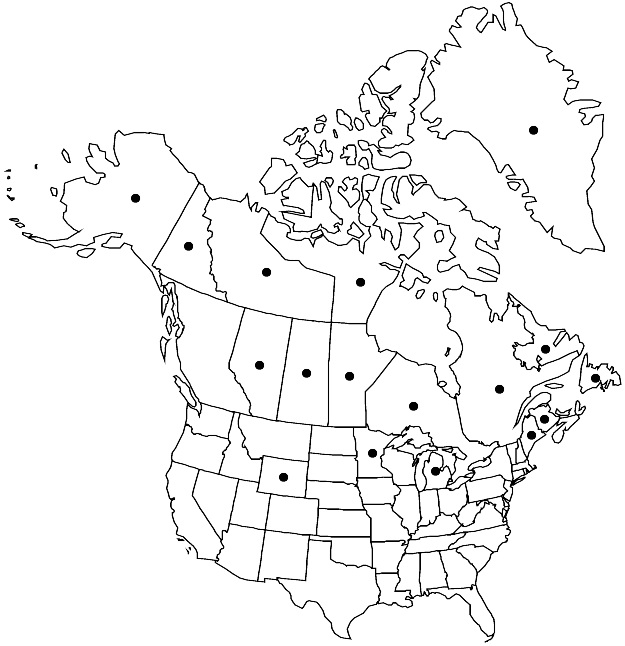Difference between revisions of "Calliergon richardsonii"
Eur. N. Amer. Bryin. 1: 80. 1897.
FNA>Volume Importer |
FNA>Volume Importer |
||
| Line 14: | Line 14: | ||
|name=Calliergon macounii | |name=Calliergon macounii | ||
|authority=Karczmarz | |authority=Karczmarz | ||
| − | }}{{Treatment/ID/Synonym | + | }} {{Treatment/ID/Synonym |
|name=C. obtusifolium | |name=C. obtusifolium | ||
|authority=Karczmarz | |authority=Karczmarz | ||
| − | }}{{Treatment/ID/Synonym | + | }} {{Treatment/ID/Synonym |
|name=C. subgiganteum | |name=C. subgiganteum | ||
|authority=Kindberg | |authority=Kindberg | ||
| Line 34: | Line 34: | ||
|elevation=low to high elevations | |elevation=low to high elevations | ||
|distribution=Greenland;Alta.;Man.;N.B.;Nfld. and Labr.;N.W.T.;Nunavut;Ont.;Que.;Sask.;Yukon;Alaska;Maine;Mich.;Minn.;Wyo.;n Eurasia;Pacific Islands (New Zealand). | |distribution=Greenland;Alta.;Man.;N.B.;Nfld. and Labr.;N.W.T.;Nunavut;Ont.;Que.;Sask.;Yukon;Alaska;Maine;Mich.;Minn.;Wyo.;n Eurasia;Pacific Islands (New Zealand). | ||
| − | |discussion=<p>Calliergon richardsonii is easily separated from other members of the genus by its comparatively short, usually branched or 2-fid stem leaf costa. The species has smaller alar regions than C. cordifolium and C. giganteum, which aids in separating it from occasional specimens of the other two that have some leaves with a slightly shorter costa than usual. Due to somewhat less spreading branch leaves and a less regular branching pattern, the plants do not become spruce treelike as in C. giganteum. Differences between 5. C. megalophyllum and C. richardsonii are provided with the former. Molecular evidence (M. Stech, pers. comm.) suggests that C. richardsonii consists of two entities, the status of which is currently being investigated.</p> | + | |discussion=<p><i>Calliergon richardsonii</i> is easily separated from other members of the genus by its comparatively short, usually branched or 2-fid stem leaf costa. The species has smaller alar regions than <i>C. cordifolium</i> and <i>C. giganteum</i>, which aids in separating it from occasional specimens of the other two that have some leaves with a slightly shorter costa than usual. Due to somewhat less spreading branch leaves and a less regular branching pattern, the plants do not become spruce treelike as in <i>C. giganteum</i>. Differences between 5. <i>C. megalophyllum</i> and <i>C. richardsonii</i> are provided with the former. Molecular evidence (M. Stech, pers. comm.) suggests that <i>C. richardsonii</i> consists of two entities, the status of which is currently being investigated.</p> |
|tables= | |tables= | ||
|references= | |references= | ||
| Line 57: | Line 57: | ||
|publication year=1897 | |publication year=1897 | ||
|special status= | |special status= | ||
| − | |source xml=https://jpend@bitbucket.org/aafc-mbb/fna-data-curation.git/src/ | + | |source xml=https://jpend@bitbucket.org/aafc-mbb/fna-data-curation.git/src/8f726806613d60c220dc4493de13607dd3150896/coarse_grained_fna_xml/V28/V28_616.xml |
|genus=Calliergon | |genus=Calliergon | ||
|species=Calliergon richardsonii | |species=Calliergon richardsonii | ||
Revision as of 17:06, 18 September 2019
Plants medium-sized to large, brownish, yellow, or sometimes green. Stems regularly radially pinnate; axillary hair apical cell short- to long-linear. Stem leaves rounded ovate, broadly rounded ovate, or rounded ovate-cordate; costa single, usually branched or distally 2-fid, 53–119 µm wide near base, 1/2–9/10 leaf length; alar region sharply delimited, triangular or usually oblong, from margins 60–80% distance to costa; medial laminal cells 50–133 × (7–)8–13(–14) µm. Sexual condition autoicous. Spores 17–31 µm.
Habitat: Wet, ± mineral-and nutrient-rich fens, ditches, shores, floating or submerged in lakes
Elevation: low to high elevations
Distribution

Greenland, Alta., Man., N.B., Nfld. and Labr., N.W.T., Nunavut, Ont., Que., Sask., Yukon, Alaska, Maine, Mich., Minn., Wyo., n Eurasia, Pacific Islands (New Zealand).
Discussion
Calliergon richardsonii is easily separated from other members of the genus by its comparatively short, usually branched or 2-fid stem leaf costa. The species has smaller alar regions than C. cordifolium and C. giganteum, which aids in separating it from occasional specimens of the other two that have some leaves with a slightly shorter costa than usual. Due to somewhat less spreading branch leaves and a less regular branching pattern, the plants do not become spruce treelike as in C. giganteum. Differences between 5. C. megalophyllum and C. richardsonii are provided with the former. Molecular evidence (M. Stech, pers. comm.) suggests that C. richardsonii consists of two entities, the status of which is currently being investigated.
Selected References
None.
